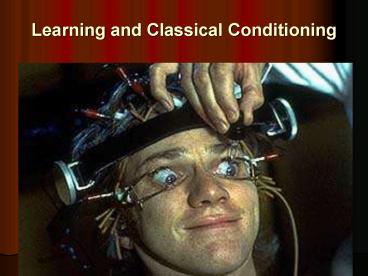Learning and Classical Conditioning - PowerPoint PPT Presentation
1 / 25
Title:
Learning and Classical Conditioning
Description:
Learning and Classical Conditioning How Do We Learn? Learning is defined as a relatively permanent change in an organism s behavior due to experience (nurture). – PowerPoint PPT presentation
Number of Views:449
Avg rating:3.0/5.0
Title: Learning and Classical Conditioning
1
Learning and Classical Conditioning
2
How Do We Learn?
- Learning is defined as a relatively permanent
change in an organisms behavior due to
experience (nurture). - Most learning is associative learning learning
that certain events occur together. - There are 3 main types of Learning
- 1. Classical Conditioning
- 2. Operant Conditioning
- 3. Observational Learning
3
Associative learning learning that two events
are linked together. Both classical and operant
conditioning are types of associative learning.
Unit 5 Learning
4
All Living Animals Learn Through Association
5
Classical Conditioning
- Terms you must understand
- Unconditioned means it is unlearned and comes
naturally/reflexively. Ex salivating when
presented with food - Conditioned means it is learned and the response
does not come naturally. Ex getting up when
school bell ring - Response is an external behavior like
salivating that occurs because of a stimulus - Stimulus external thing, like a bell or food,
that may cause a response (behavior)
6
Father of Classical Conditioning is Ivan Pavlov
- Russian physician/ neurophysiologist
- Was studying digestive enzymes in dogs when he
accidentally realized the importance of
associative learning which would consume his
research for rest of his life.
7
Dog in Pavlovs Apparatus (clip)
8
Classical Conditioning (Pavlovian Conditioning)
- Classical Conditioning is a type of learning in
which a neutral stimulus (i.e. a sound) causes a
conditioned response when that stimulus is paired
with an unconditioned stimulus that causes an
unconditioned response. - Begins with a reflex which is unconditioned
(unlearned) - A neutral stimulus is paired with a stimulus that
evokes the reflex. - Eventually the neutral stimulus alone will come
to evoke the reflex.
9
Components of Classical Conditioning
- Unconditioned Stimulus (UCS)
- effective stimulus that unconditionally-automatic
ally and naturally- triggers a response - ex. food
- Unconditioned Response (UCR)
- unlearned, naturally occurring automatic
response to the unconditioned stimulus - Ex. salivation (when food is in the mouth)
10
Components of Classical Conditioning
- Conditioned Stimulus (CS)
- previously neutral stimulus that, after
association with an unconditioned stimulus, comes
to trigger a conditioned response Ex. Tone or
bell - Conditioned Response (CR)
- learned response to a previously neutral
conditioned stimulus ex. Salivation (when the
tone or bell is heard)
11
Pavlovs Classic Experiment
12
Can I Get A Volunteer to Be Conditioned?
13
What's the Point?
- Classical conditioning helps people and animals
to - ?adapt to their environment
- avoid poisonous foods.
- ?deal with dangerous situations
14
Pavlov's Dog in the Office
15
Pavlovs Dog the Office
UCS (unconditioned stimulus)
offer of mint
UCR (unconditioned response)
put hand out
NS (neutral stimulus)
da-duh
CS (conditioned stimulus)
da-duh
CR (conditioned response)
put hand out
16
Extinction
- Extinction the diminishing of a conditioned
response. - How would you make extinction occur?
- If the conditioned stimulus occurs repeatedly
without the unconditioned stimulus, eventually
the conditioned response will cease. - ex. If Pavlov kept making the tone (CS) without
offering the food (US), the salivation (CR) would
eventually stop.
17
Generalization vs. Discrimination
- Generalization tendency for a stimuli similar
to CS to evoke CR. Ex doesnt have to be same
tone to make dogs salivatethey generalize. It
could be bell or something else similar to the CS - Discrimination the ability to distinguish
between a CS and other similar stimuli .
Ex dogs wouldnt salivate to a whistle since it
was too different from the tone.
18
Lets Read About Little Albert!
19
- John Watson conducted the Little Albert study in
1920 in which he attempted to modify the behavior
of a 9 month old infant. Started with white rat
which infant originally did not fear. - After experiment, Little Albert feared white
rats, rabbits, Santa Claus, cotton wool, etc.
20
Identify Components of theLittle Albert Study
- Unconditioned Stimulus (UCS)
- Unconditioned Response (UCR)
- Conditioned Stimulus (CS)
- Conditioned Response (CR)
- Generalization
loud noise
fear/anxiety
white rat
fear/anxiety
Other furry animals
21
Garcias Taste Aversion Studies
- Set up experiment with rats. Exposed them to
sights, sounds, and tastes (CS) and later also
gave them radiation or drugs that led to nausea
and vomiting (UCR). - Even if sickened hours later, rats avoided the
particular flavor of water but did NOT develop
aversions to the sights or sounds. - Taste Aversion became known as the Garcia
Effect.
22
Importance of Taste Aversion Studies
- Shows that nature prepares the members of each
species to learn those things crucial to their
survival. - One pairing (unlike many pairings for a typical
classical conditioning experiment) is typically
all that is necessary to bring about the CR.
23
Some Real World Applications of Classical
Conditioning
- Crack cocaine users feel craving when they
encounter cues associated with highs (people,
places, etc). So drug and rehab counselors
advice them to steer clear of these places and
peoplemake new friends, move. - Pairing alcohol with a drug that induces vomiting
is sometimes successful in getting alcoholics to
stop drinking.
24
Country Time Salivation Activity
25
Counterconditioning
- Getting rid of a fear by associating it with
something pleasant. - Ex. Eliminate a fear of mice by exposing the
subject to mice while providing a pleasant
stimulus like cookies or candy.

